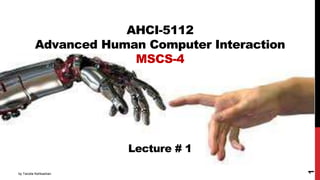
Adv. HCI Lecture1 - Introduction
- 1. AHCI-5112 Advanced Human Computer Interaction MSCS-4 Lecture # 1 by Tanzila Kehkashan 1
- 2. Assessment & Evaluation Criteria • Quizzes 10 % • Assignments 10 % • Project / Presentation 15 % • Mid Term 25 % • Final Term 40 % • Total: 100 % by Tanzila Kehkashan 2
- 3. History of HCI • 1982; first conference on Human Factors in Computing Systems in Gaithersburg (Maryland, United States) • The terms “office automation” and “office information systems” were popular in the late 1970s. Wave 1: Desktops & mental models (1980s — 1990s) • HCI was mainly focused on creating systems that were easy-to-learn and easy-to-use • This era was all about usability, and we learned a great deal about what people could and couldn’t do while completing tasks on a computer.
- 4. History of HCI Wave 2: Collaboration & communication (1990s — early 2000s) • Email gained popularity during this time, which meant that people were not just interacting with computers — they were interacting with each other through computers. • There was growing interest in how computers were used to support communication and collaboration, signaling the rise of social and organizational computing. Wave 3: Self-expression, social change (mid 2000s — 2010s) • During this era, value-driven design takes the lead in engaging communities and designing for sustainable change. • During this era, HCI draws increasingly from philosophy and ethics to provide rhetoric on the consequences of habit-forming technology, and the responsibility of their creators.
- 5. HCI Research Contributions • What is considered HCI research? • What types of effort are considered research contributions? Types of research contributions i. Empirical contributions ii. Artifact contributions iii. Methodological contributions iv. Theoretical contributions v. Dataset contributions vi. Survey contributions vii. Opinion contributions • Majority of HCI research falls into either empirical research or artifact contributions
- 6. Evolution of HCI Research Topics • In the 1980s was often about how people interacted with simple (or not so simple) office automation programs, such as word processing, database, and statistical software. • Towards the late 1980s, graphical user interfaces started to take hold. • In the late 1980s and early 1990s, there was growth in the area of usability engineering Methods. • But there was a major shift in the field of HCI research during the early to mid 1990s, as the Internet and the web gained wide acceptance. • New types of interfaces and communication, such as web pages, e-mail, instant messaging, and groupware, received attention from the research community. • In 1994–2003, which focused on fixed technology, and research from 2004–13, which focused on mobile and portable computing (such as tablets and smart phones). • Around 2004–05, the focus of research shifted more towards user-generated content that was shared, such as photos, videos, blogs, and wikis, and later grew into research on social networking.
- 7. Evolution of HCI Research Topics • In the late 2000s, research increased on touch screens, especially multitouch screens, with studies on motor movement focused on pointing using fingers, rather than computer mice. • Research focus in the late 2010s is no longer on something as simple as task performance in statistical software, but is now more focused on collaboration, connections, emotion, and communication. • Today's research focuses on topics such as mobile devices, multitouch screens, gestures and natural computing, sensors, embedded and wearable computing, sustainability, big data, social and collaborative computing, accessibility, and other topics.
- 8. Inherent Trade-offs in HCI • There are inherent conflicts in HCI research and design. • We make trade-offs and accept “better solutions” rather than optimal solutions. • We have multiple stakeholders and not all of them can be satisfied. • Design is not simple and it's not an optimization problem. • Good HCI research allows us to understand the various factors at play, which design features may work well for which users, and where there are potential conflicts or trade-offs. • For example, we can learn how to make interfaces that are far better than our current interfaces. • However, users may not prefer those interfaces because they are so different from the current interfaces. • So maybe we should modify our interfaces gradually, making only minor changes each time? • Example; Keyboards
- 9. • Generally, tree structures in menu design can be implemented as narrow and deep or as broad and shallow. • The research has consistently pointed to broad, shallow tree structures as being superior to narrow, deep structures. Trade-offs between Depth and Breadth in Menus Types of tree structure in menu design: (A) narrow-deep: three levels with two choices at each level, (B) broad- shallow: two choices followed by four choices, (C) broadshallow: four choices followed by two choices.
- 10. • There are many possible reasons: • users get more frustrated and more lost, the more levels they must navigate; • users are capable of dealing with more than the 7 ± 2 options often cited in the research literature (since menus deal with recognition, not recall), and • strategies for scanning can lead to superior performance. • Different research methods and different research teams, examining different users, have all come to the same conclusion. • So over time, the superiority of broad, shallow tree structures has become well-accepted as a foundation of interface design. Trade-offs between Depth and Breadth in Menus
- 11. Assignment # 1 1. What is triangulation? Why is it important in HCI? 2. What do you think the field of HCI research will look like in 20 years?